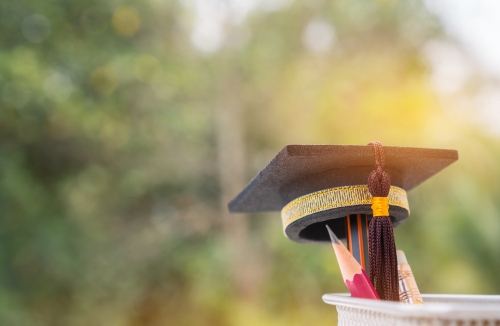
Graduate students researching graduate schools often wonder if graduate programs with a lower acceptance rate are usually more expensive. Selective colleges and universities can have acceptance rates as low as five percent, and it’s often assumed that selective schools have higher tuition and fees. Different factors affect the cost of tuition, with private universities having higher costs than public universities. Graduate programs with lower acceptance rates are usually more expensive than programs offered at schools with higher acceptance rates.
Selective Schools and Higher Tuition and Fees
Selective schools, those only accepting up to 35 percent of applicants, do have higher costs on average than schools with higher acceptance rates. The overall higher tuition and fees means that graduate programs will cost more than graduate programs at less prestigious schools. Prestige is what differentiates a selective school with strict admissions policies from an average school with less stringent admissions policies. Many Ivy League schools have low acceptance rates and high costs, but not necessarily because the programs offered are superior to competing programs at other schools. CNBC explains that to attract students, prestigious universities spend millions renovating buildings or building new facilities and also recruit top instructors that demand higher pay. Leisure and entertainment amenities are another way these universities try to attract students, and when endowments get low these costs are passed on to students through rising tuition. So when wondering are graduate programs with a lower acceptance rate usually more expensive, keep in mind that many factors affect tuition costs.
Identifying the Bloat
The same CNBC article noted that tuition rates have risen across the board for selective and non-selective schools. As a matter of fact, tuition generally rises at a rate six percent above inflation. Another factor influencing these rising rates is lower application numbers. Applications peaked in 2011, but they are dropping now. Public schools, which are usually less selective, receive more state money. Private schools rely heavily on donations and endowments. Of course, there are selective private schools that receive state subsidies, but these usually are larger institutions with ongoing research programs. Smaller schools without such endeavors depend upon alumni donations to cover the costs not only of maintaining buildings and paying staff, but of recruiting students.
Recruitment depends upon not only highlighting programs but in making the school itself desirable. These schools are not trying to attract the average student. They are looking for upwardly-mobile, high achieving students who can afford to pay the tab. These schools may have comfortably appointed furnishings in their on campus apartments and will usually boast the highest tech and most advanced resources in their classrooms. One of the biggest lures for the kind of applicants selective schools are seeking is sports. Some private, highly selective schools have highly-ranked teams. Others have teams that aspire to be great. They pay high salaries to get high-performing coaches. The thing is, not all students participate in sports, so those students unwittingly help subsidize the programs through fees that may be labeled “student services.”
Sports programs, however, represent a smaller percentage of student services than does the addition of non-teaching employees. The number of these jobs increased by 28 percent between 2000 and 2012. While they may be providing an expanded student service program, their necessity is debatable, according to the CNBC article, and certainly adds to the cost of a graduate degree.
Amenities at these more-selective institutions also include things like the availability of extracurricular programs and travel opportunities, but many schools tout their locations to attract students able to afford the higher tuition. Some schools located in the mountains, for instance, offer mountain bikes or ski usage to students. All of these things, the “ bloat,” as CNBC calls it, are investments the schools make to attract students. The old axiom applies that “to make money, you have to spend money.”
Graduate Program Cost Comparisons

Applicants will find that schools with lower acceptance rates have higher tuition rates, although selective schools may offer a set tuition rate for all students rather than utilizing in-state and out-of-state tuition options. For example, New York University is a selective school with an average acceptance rate of around 35 percent and their doctorate of physical therapy degree is over $130,000, while Florida International University, which accepts almost half of its applicants, charges a little over $75,000 for the same degree. However, the lower cost is only for residents of Florida. Those applying from out of state will pay over $130,000 for the doctorate in physical therapy degree, which is the same as the costs at New York University, a school with a proven lower acceptance rate to its graduate programs.
Selective schools may put more effort into finance packages than public universities or less-selective institutions to attract more applicants. That is, they may assemble a combination of subsidies, scholarships and other incentives that will make them more affordable or even promise that students will graduate debt-free. Amherst College, for example, has an acceptance rate of just over 13 percent, and has a no-student-loan policy that guarantees graduates will not accumulate student debt.
Costs and Quality
The cost of a graduate program at a selective school will have a higher price tag, but the quality of the program may be comparable to a graduate program offered by a less selective school. Compare in-state and out-of-state tuition with set tuition rates when comparing graduate programs. In many cases, the out-of-state tuition rates will rival the set tuition charged by a school with low acceptance rates. U.S. News provides an annual ranking of graduate programs by school, which makes it easy to research tuition and fees.
Lower acceptance rates do usually mean more expensive programs, but that doesn’t mean the quality of the program is superior to another school. Prospective graduate students will find that most selective schools have fees comparable to other schools, especially when paying out-of-state tuition. This should help answer the question about if graduate programs with a lower acceptance rate usually more expensive.
Apples and Oranges: Cost vs Return

When figuring the cost of a graduate degree, students must also look at the ROI, or return on investment. According to an article in Insidehigher ed.com, graduates of the most selective institutions make more money after graduation. The article cites a report from the Obama administration that says Harvard University graduates earn $87,200 ten years after graduation, while those students who graduated from the University of Massachusetts earned $46,000. This figure reflects the earnings after a four-year bachelor’s degree, but applies similarly to graduate programs. Additionally, the difference may not be completely attributed to the quality of the programs, but also to the kind of student the more selective schools attract.
Other studies seem to show that programs at selective schools and less-selective institutions were comparable and faculty just as accomplished. Employers, these studies showed, were less concerned about the name of the institution than by the skill sets of the job applicants. The data suggests that where a student earns an undergraduate degree is not as important as where he went to graduate school. The name of the graduate school listed on a job application, however, is more significant. This is the most applicable point in fields like medicine and business.
All graduate programs require some level of sacrifice on the part of students. The ROI for graduate degrees also must take into account things like the “opportunity cost of attendance.” The article points out that if students earn $40,000 a year but lose that year to earn their degree, the cost to them is $40,000. Of course, if ten years after graduation students earn twice that amount , then the investment ameliorates the cost of the degree. The $40,000 for the opportunity to attend the more prestigious school has been a good investment.
Requirements to be Accepted
The requisites to get into a graduate program vary between selective and non-selective schools, but they also vary between programs. That is because graduate students are generally applying to a program or a department and not to the university in general. The graduate school acceptance rates between departments of selective schools vary as well. That means a university that accepts 60 percent of applicants may have a graduate school that is highly selective. For instance, at Dartmouth, the master’s program in arts and sciences admits 30 percent of applicants, but the Thayer school of Engineering at Dartmouth only accepts 15 percent. The Stern School of Business at New York University accepts less than three percent of those who apply to it, while the university, though selective, accepts more than 20 percent.
Generally, graduate admission requisites include a transcript of undergraduate grades. Selective schools may also ask for secondary school transcripts as well as grades from extracurricular programs or overseas opportunities. Less selective schools may make graduate exams such as the GRE or GMAT optional, while at schools where there is more competition to be admitted the tests are usually required. Many sources recommend that students applying to a selective graduate school take the exams even if they are not required. This includes the subject tests of the GRE. Additionally, all schools require letters of recommendation, but selective schools may weigh letters from alumnus higher than other schools.
Affording the “Best”

A student who is accepted at a more selective graduate program is probably from a higher-than-average income group to begin with. Still, if he or she decides on the selective school, how can the program be made more affordable? Many sources suggest looking for paid assistantships but point out that even unpaid positions yield a savings because they provide added experience that is a plus on a job application.
Looking at the immediate earnings after graduation and comparing it with the expense of the program is an indicator of whether the program is a good investment. A way to do that is by checking the list of alumni to see where they stand in their professions and in their earnings.
The Feasibility of Selective Schools for Students of Color
An article in Forbes Magazine points out that the selective graduate school acceptance rates for students of color are lower than for other students. That is important in this time of increasing scrutiny on racial equality. Part of the disparity stems from the fact that more of these students are from lower-income families. The Education Trust is a non-profit organization that tries to close “opportunity gaps” for students of color and other minorities as well as low income students. They have examined “flagship universities” as well as other selective schools and graded them on an A-to-F scale. Most of the schools they studied earned “D’s” or “F’s” in the enrollment of these students.
If a graduate program in a selective school gives students an edge in earnings, as studies seem to show, then the fact that they may be more expensive than less-selective programs represents a barrier for students of color. According to the article, these schools which have significantly larger endowments, can afford to admit these students to the institutions but fail to do so. While it is easier to encourage public schools to make more efforts on this front, it is more difficult to affect change in the private sector of selective schools.
While costs of higher education are skyrocketing, applications are dropping. In reality, even not-for-profit graduate schools are businesses, and they cannot afford to operate at a loss. They reinforce their rankings by screening applicants carefully and by accepting only the best. To attract these students, they may offer amenities such as comfortably furnished apartments, extracurricular activities and state-of-the-art scholastic resources.
The schools may charge higher tuition and student fees, but they often attempt to offset this by offering attractive financial aid packages that may allow students to graduate with little or no student debt.
That debt must be reconciled with the opportunity that a “big name” school or even a lesser-known but selective school can give students with that school listed on a job application. Additionally, selective school graduates may earn more over their lifetimes than those from less-selective schools.
So even though graduate programs in selective schools are generally more expensive than less selective programs, they may compensate for that difference in meeting the higher expectations of their applicants.
Although teacher salaries have remained flat for the most part, schools that are more selective may pay higher salaries for some professors to attract top “talent.” That doesn’t always equate to better programs, because many schools rely on part-time instructors to make up the cost difference. Additionally, program rankings in selective schools may be skewed because their standards for admission are higher while less selective schools may have lower rankings because of the diversity of their students.
Resources:
- Top 20 Master’s Degree Programs at Smaller Colleges in the NorthTop
- 20 Master’s in Healthcare Online/Online MBA in Healthcare Administration
- 25 Great Scholarships for Healthcare Management Students
- Top 20 Certification Programs in Healthcare Management
- Can I Work in a Hospital with a Healthcare Management Degree?
- How Are Hospitals Becoming More Eco-friendly?
- How Much Does a Hospital Administrator Make?
- What Jobs Are Available in a Hospital Setting with a Healthcare Management Degree?